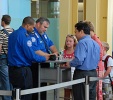
TSA Expanding Explosive Trace Detection Measures at Airports Nationwide
The U.S. Transportation Security Administration announced it will begin randomly swabbing passengers' hands at U.S. airports to check for traces of explosive materials in the coming weeks. Describing the policy as "an additional layer of security," TSA said it initially went into effect on a limited basis at five previously unidentified airports following the attempted bombing of a U.S. airliner over Detroit on Christmas Day 2009. Now the program will be expanded.
"Explosive Trace Detection [ETD] technology is a critical tool in our ability to stay ahead of evolving threats to aviation security," said TSA Acting Administrator Gale Rossides. "Expanding the use of this technology at checkpoints and at departure gates greatly enhances security to keep the traveling public safe."
TSA said screeners already randomly swab carry-on luggage and other objects at checkpoints. Soon now, though, travelers can expect to see the increased random use of ETD technology in different areas, including checkpoint lines and at boarding gates. Officers may swab a piece of luggage or passengers' hands, then use ETD technology to test for explosives. The swab is placed inside the ETD unit which analyzes the content for the presence of potential explosive residue. To ensure the health of travelers, screening swabs are disposed of after each use. Since it will be used on a random basis, passengers should not expect to see the same thing at every airport or each time they travel.
The U.S. Department of Homeland Security said it does not expect the tests to significantly increase wait times at checkpoints.
To date, the Department has awarded $15 million in American Recovery and Reinvestment Act funding for 400 fixed ETD units. Additionally, President Obama’s fiscal year 2011 budget prioritizes key investments in aviation security, including $39 million to purchase approximately 800 portable ETD machines.
TSA revealed that the five airports at which it piloted use of the ETD technology following the failed Christmas Day attack were Raleigh-Durham International Airport, Hartsfield-Jackson Atlanta International Airport, Orlando International Airport, and Pitt-Greenville and Coastal Carolina Regional Airports in North Carolina.